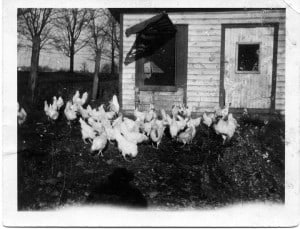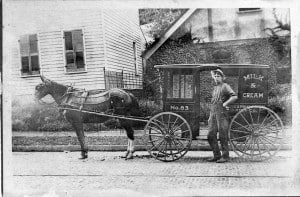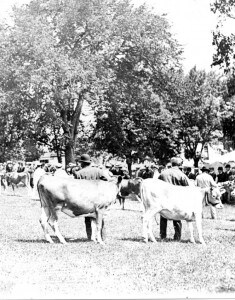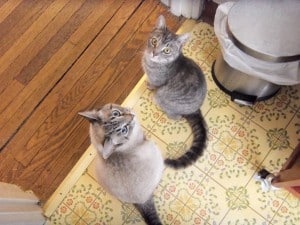Swine Driver and Pound Keeper for Geneva in 1852
By Karen Osburn, Archivist and City of Geneva Historian
Recently I read the Village of Geneva minutes of the Common Council for the time period May 18, 1852 to May 11, 1853. In that roughly one year period there were at least 11 mentions of Swine, Cattle and the “Pound”. The entries began with William Earl being appointed Swine Driver and pound keeper. A month later, he was removed from office and Luther Stockwell appointed instead. Between March and April 1853 there is the notation of “another election” and Henry Snelling is listed as Swine Driver and Pound keeper. The next entry, April 13, 1853, indicates that Henry refused to serve and John Payne was appointed in his stead. The month following that announcement, May 1853, it is announced that Payne’s appointment was rescinded and William Earl reappointed to position of Swine Driver and Pound Keeper and also placed in charge of public parks. Whew! That is a lot of changes for one political appointment!
Checking the Geneva Newspaper Index I found few articles on loose farm animals running the street. In fact, I only found 3 references in the index. However, in September of 1852 a man was prosecuted for “breaking open the pound” and remarks in January and March of 1853 made reference to a man forcibly removing cows from the pound keeper’s possession. It appears there was a need for the position and some displeasure over how the responsibilities were carried out.
This may be difficult for us to relate to nowadays, but if we spend a few moments thinking about it we realize that livestock often represent a large portion of a farmer’s wealth in any time period. Furthermore loose livestock can be a pesky annoyance at best and a danger to the citizens of an urban area at worst. Anyone who has spent much time around farm animals realizes they can be unpredictable. They are just being animals, but since we are just being people, and many of us are people with limited experience with livestock, we often misunderstand an animal’s actions.
Imagine waking up one morning to a cow munching your carefully tended flower garden, when you step outside to confront the creature you realize not only has she decimated your garden, she has also “fertilized” your sidewalk and broken down your raspberry canes. When you approach the bovine, with broom in hand, the cow looks at you complacently and turns her horns in your direction….they look a bit intimidating don’t they?
In an era when many a city family may have kept a cow, pig or horse for milk, meat or transportation it was not unheard of to find they had escaped and were distressing your neighbors. Today, this type of animal interaction seldom occurs in urban areas, but in the transitional areas between farm and city it is much more common to look out your window and find your neighbors’ grey pony consuming your bird seed in competition with a wily raccoon.
My own encounters with livestock have been mostly benign, but several of them have been more interesting than I expected. I lived in a rural area for a large portion of my life and experienced some moments that branded themselves in my brain. When I was very young a team of horses escaped from the farm across the street and came galloping through our yard, frightening my mother while I gaped in awe at their thundering hoofs disappearing into the field behind our house. Then there was the time when I encountered an entire herd of loose draft horses while driving down a country road someplace west of Rochester. The horses surrounded our small car and escorted us down the street with our eyes about level with their bellies. Unbelievably, nobody I spoke to knew whose horses they were!
As a child my parents and I visited a farm where pigs were raised. While the adults were chatting, I went with the other children into the barn to see the new piglets. I discovered how fast you can run with a “barking” sow chasing you out of a barn. How did we know she thought we were dangerous to her babies?!
That experience left me less than enchanted with pigs. Imagine my thoughts when I moved to the country as an adult and discovered feral pigs on my property! Apparently the neighbor’s pigs had escaped and he had recaptured all but two. Those two hogs decided that being free was preferable to being sausage and did their best to remain wandering adventurers. At that time we had just completed building a house, an endeavor which left us little money to spend on a lawn mower. The resulting meadow was about 2 feet high and I was standing on the front steps surveying the situation when I noticed the vegetation in front of me parting and a pair of pigs’ backs cruising through what was masquerading as a lawn. Shortly afterward we borrowed a scythe from my father in an attempt to “tame” the pasture and the pigs were eventually trapped by another neighbor and properly confined.
Then of course there were the cows. Another neighbor kept dairy cows of a large and crafty variety. (Anyone who has stood next to a Holstein knows these are BIG animals.) They were continually escaping his fence and standing in the middle of the road, just over the crest of a hill where you could not see them when you were headed south up the hill. My first encounter with them taught me to crawl over the crest of the hill at a reasonable speed, but it took another neighbor hitting a cow with a truck to encourage the farmer to put up a cow crossing sign. The idea of a cow or swine driver and a pound for the offending livestock is beginning to sound pretty good isn’t it?
Many of us think of a “pound” as a place that takes in dogs and cats temporarily. That is because in our urban areas today these are the animals that commonly need a shelter from neglect or a clearing center to be reunited with their owners. One hundred and fifty years ago it was pigs, cattle, sheep, goats and horses that suffered from neglect or wandered off. Sometimes their owners were cruel, but more often than not they simply were not aware their pigs or cows had wandered off, or if they did thought they would just go and collect them later. Wandering livestock caused problems and necessitated the position of Swine driver and pound keeper be filled by a responsible person. In an area where most people knew their neighbors and their animals it was easier to return an animal to the right owner than it is today, when many of us are not familiar with our neighbors due to available time and work schedules.
Even today organizations like Lollipop Farm in Victor, NY are home to a variety of farm animals that have been abused or neglected or turned over simply because their owners are no longer able to care for them. Bunnies, lambs, pigs, llamas, horses, ponies, sheep, goats and cows all come through the doors of these rescue/rehabilitation places in search of veterinary care or a new home.
To end this article on a positive note, please consider adoption when you are considering adding an animal to your family. There are wonderful animals available who will be grateful for a good home and you will be rewarded with a great new friend.




